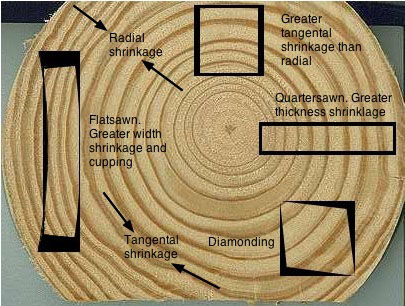Drying Softwoods
Rules of thumb:
- Slowing the drying rate reduces defects such as internal checking, collapse, case hardening and surface checking. However, if timber is dried too slowly sapstain and mould growth can discolour the timber.
- The thicker the timber, the longer the drying time, and the more difficult it is to dry without degrade. Checking is much more likely as thickness increases. Where internal checking takes place (e.g. Western red cedar) ripping the timber to smaller sizes results in significant surface checking degrade on the ripped face.
Seasoning flatsawn vs quartersawn timber
- The radial surface of timber dries faster. Flatsawn

i.e. milled with growth rings tangential to the wide faces. Flatsawn boards have greater width shrinkage and cupping timber dries faster than Quartersawn
i.e. milled with growth rings close to perpendicular to the wide faces of the board. Quartersawn boards have greater thickness shrinkage timber in the same conditions, but generally needs to be dried more slowly to minimise degrade. - Timber will shrink more tangentally

Tangental shrinkage is greater than radial, about twice as much as radially. Flatsawn boards are more prone to cupping .
. - Crook
 can be an issue with true quartersawn boards (pith to bark).
can be an issue with true quartersawn boards (pith to bark).
The species
Cypress
Lawsons cypress seasons rapidly and with little degrade. It can be kiln dried from green without internal checking or collapse. Lawson and Leyland cypress should have the sap and heart segregated when fresh as its harder to differentiate heart and sap in the seasoned state.
Macrocarpa and lusitanica
Macrocarpa and lusitanica should not be kiln dried from green. To avoid collapse and checking the timber should be air dried to around fibre-saturation point before finishing in a kiln using a mild schedule.
Farm-totara
Farm-totara should be slowly air dried and can be finished in a kiln with a mild schedule.
Redwood
Time for air drying redwood increases with thickness. With good airflow 50mm thick stock can be dried in 6-8 weeks to around 20% moisture content, while 100 mm boards can take around 30 to 40 weeks. A 200 mm beam may take 3 years or more. Air dried redwood can be finished in a kiln, or can be kiln dried from green using a slow kiln schedule (temperatures below 40°C, especially early in drying).
Paper wasps can chew the wood as its air-drying.
Cedar
Western red cedar is prone to collapse
Collapse in Western red cedar and internal checking
Internal checking exposed by bandsawing into thinner stock as it dries. Thinner section material should be preferably quartersawn then air-dried to near fibre-saturation point before finishing in a kiln with a mild schedule.
Japanese cedar (Cryptomeria japonica) seasons well with little degrade if air dried to near fibre-saturation point before finishing in a kiln using a slow schedule.
Paper wasps can chew cedar as it is seasoning.
Softwoods which can be seasoned easily are usually flatsawn allowing wider boards to be cut from smaller trees and with faster drying times. However, with wide flatsawn boards cupping becomes a consideration, and movement in service may be an issue with quality joinery made from wide flatsawn boards.
Fibre saturation point
The initial stage of air drying aims to reach fibre saturation pointFibre saturation point: The moisture content at which moisture is saturated within the cell walls of wood and the cell cavities are free of water. Fibre-saturation point occurs at 25% MC to 32% MC depending on the species. Below FSP water is held in wood as bound water within the cell cavities or lumen. with minimal degrade. In practice this is best achieved with slow air drying. Once the centre part of the board reaches fibre saturation point it starts to shrink. There is now less tensile stress at the surface (which had previously shrunk) and the timber can now be dried more quickly with a kiln through to the required final moisture content.
Final kiln drying
Timber can either be air dried slowly to a suitable moisture content or air dried and then finished in a kiln to the required final moisture content.
Timber with different drying characteristics or different thicknesses cannot be dried in the same kiln charge without slowing overall drying, or risking degrade to the material requiring the slowest drying regime.
Because conventional kilns dry wood quite rapidly, moisture gradients may develop between the centre and surface of the board. For most specialty species it is important to keep shedules mild and reduce the moisture slowly.
Dehumidification kilns operate at low temperatures and thus drying rates are slow, producing low levels of degrade. Dehumidifiers are recommended for smaller operations and for "finishing" air-dried timber.
A "safe" schedule for dehumidifying air-dried timber (i.e. at fibre saturation point) is:
- Retain full humidity and heat to 39°C for 7 days.
- After 7 days start extracting moisture: reduce humidity to 75% for 4 days, then lower humidity again. Humidity should never be below 45% and temperature never above 40°C.
- Test moisture content at regular intervals with a moisture-meter and the charge can be removed when dried to the required moisture content (usually 10-12%).
Processing
For processing the timber should be stable, with the correct moisture content, an even moisture profile and minimal residual stress.
Storage
Moisture content of timber should not move outside the range for its intended use. The moisture content of dried timber will reach equilibrium with the ambient conditions of the surrounding environment. This should not change if the storage area is completely enclosed in an insulated building with temperature and humidity control.
Satisfactory storage may also be achieved if the storage area is completely enclosed in a building. This minimises air movement and eliminates uncontrolled sources of moisture.
If the storage area is only partially enclosed packs should be plastic wrapped. However, plastic wrapping only provides short-term protection from external conditions.
See also Sawmilling Softwoods - The Issues »
Disclaimer: While every effort is made to ensure the accuracy of the information provided on this site, Farm Forestry Timbers Society do not accept liability for any consequences arising from reliance on the information published. If readers have any doubts about acting on any articles they should seek confirming, professional advice.
 Farm Forestry New Zealand
Farm Forestry New Zealand Farm Forestry Timbers - Headlines
Farm Forestry Timbers - Headlines